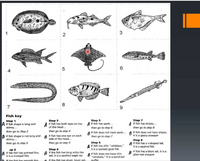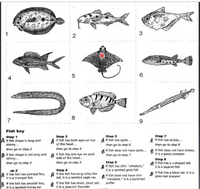
Human Anatomy & Physiology (11th Edition)
11th Edition
ISBN: 9780134580999
Author: Elaine N. Marieb, Katja N. Hoehn
Publisher: PEARSON
expand_more
expand_more
format_list_bulleted
Concept explainers
Question
Here are 9 fish species. Use the accompanying dichotomous key to identify the Genus and species of each.

Transcribed Image Text:## Fish Identification Guide
### Illustrative Figures of Various Fish
This guide contains illustrations of different types of fish. Each fish is numbered for easy reference. Below each illustration is a series of steps to help identify the fish.
1. Fish with a round flattened body and small fins.
2. Fish with two dorsal fins, one of which is long and extends along the back.
3. Fish with a single dorsal fin and a rounded body.
4. Fish with a triangular shape and large pectoral fins.
5. Fish with a diamond-shaped body and long tail.
6. Fish with a long body and small fins.
7. Fish shaped like an eel, slender and elongated.
8. Fish with a round, deep body and small fins.
9. Fish with a long, slender body and long snout.
### Fish Key
Follow the guide below to identify the fish based on their physical features.
#### Step 1:
- **A**: If fish shape is long and skinny, then go to Step 2.
- **B**: If fish shape is not long and skinny, then go to Step 3.
#### Step 2:
- **A**: If the fish has pointed fins, it is a trumpet fish.
- **B**: If the fish has smooth fins, it is a raft fish.
#### Step 3:
- **A**: If fish has both eyes on top of the head, then go to Step 4.
- **B**: If fish has one eye on each side of the head, then go to Step 5.
#### Step 4:
- **A**: If the fish has long whip-like tail, it is a spotted eagle ray.
- **B**: If the fish doesn't have long whip-like tail, it is a short-tailed rudge.
#### Step 5:
- **A**: If fish has spots, then go to Step 6.
- **B**: If fish does not have spots, then go to Step 7.
#### Step 6:
- **A**: If fish has chin "whiskers," it is a spotted goat fish.
- **B**: If fish does not have chin "whiskers," it is a band-tail puffer.
#### Step 7:
- **A**: If fish has stripes, then go to Step 8.
- **B**: If fish does not have stripes, it is a

Transcribed Image Text:# Fish Identification Key
The image provides a fish identification key, utilizing a step-by-step process to help identify various species of fish based on their physical characteristics. Below is a transcription and detailed explanation of the diagram and instructions provided in the image.
## Fish Key Steps
### Step 1
- **A**: If fish shape is long and skinny...
- **then go to Step 2**
- **B**: If fish shape is not long and skinny...
- **then go to Step 3**
### Step 2
- **A**: If the fish has pointed fins, it is a **trumpet fish** (Image 9).
- **B**: If the fish has smooth fins, it is a **spotted moray eel** (Image 7).
### Step 3
- **A**: If fish has both eyes on top of the head...
- **then go to Step 4**
- **B**: If fish has one eye on each side of the head...
- **then go to Step 5**
### Step 4
- **A**: If the fish has long whip-like tail, it is a **spotted eagle ray** (Image 5).
- **B**: If fish has short, blunt tail, it is a **peacock flounder** (Image 6).
### Step 5
- **A**: If fish has spots...
- **then go to Step 6**
- **B**: If fish does not have spots...
- **then go to Step 7**
### Step 6
- **A**: If fish has chin "whiskers," it is a **spotted goat fish** (Image 2).
- **B**: If fish does not have chin "whiskers," it is a **band-tail puffer** (Image 1).
### Step 7
- **A**: If fish has stripes...
- **then go to Step 8**
- **B**: If fish does not have stripes, it is a **glassy sweeper** (Image 3).
### Step 8
- **A**: If fish has a V-shaped tail, it is a **squirrel fish** (Image 4).
- **B**: If fish has a blunt tail, it is a **glassy-eye snapper** (Image
Expert Solution
This question has been solved!
Explore an expertly crafted, step-by-step solution for a thorough understanding of key concepts.
This is a popular solution
Trending nowThis is a popular solution!
Step by stepSolved in 2 steps

Knowledge Booster
Learn more about
Need a deep-dive on the concept behind this application? Look no further. Learn more about this topic, biology and related others by exploring similar questions and additional content below.Similar questions
- Please create an interactive dichotomous key for the following animals: Leopard, Squirrel, Dog, swine, and Asian elephant.arrow_forwardLook at the image below. What type of invertebrate do you think this is? What characteristics lead to this conclusion? What information would you need to be certain? If you are uncertain about what this is (or even what phylum it belongs to) give the options you are considering?arrow_forwardDescribe the process we use to infer the phylogenetic relationships of a set of living organisms.arrow_forward
- Look up 5 other species that are in the same order as your species and create a dichotomous key that could be followed to ID your species. SPECIES: Pandaarrow_forwardIn a mimimum of 25 sentences explain why subspecies are important in the field of taxonomy. Also explain why some taxonomist do not use subspecies. Provide a clear paragraph and give examples if possiblearrow_forwardGive typing answer with explanation and conclusionarrow_forward
arrow_back_ios
arrow_forward_ios
Recommended textbooks for you
 Human Anatomy & Physiology (11th Edition)BiologyISBN:9780134580999Author:Elaine N. Marieb, Katja N. HoehnPublisher:PEARSON
Human Anatomy & Physiology (11th Edition)BiologyISBN:9780134580999Author:Elaine N. Marieb, Katja N. HoehnPublisher:PEARSON Biology 2eBiologyISBN:9781947172517Author:Matthew Douglas, Jung Choi, Mary Ann ClarkPublisher:OpenStax
Biology 2eBiologyISBN:9781947172517Author:Matthew Douglas, Jung Choi, Mary Ann ClarkPublisher:OpenStax Anatomy & PhysiologyBiologyISBN:9781259398629Author:McKinley, Michael P., O'loughlin, Valerie Dean, Bidle, Theresa StouterPublisher:Mcgraw Hill Education,
Anatomy & PhysiologyBiologyISBN:9781259398629Author:McKinley, Michael P., O'loughlin, Valerie Dean, Bidle, Theresa StouterPublisher:Mcgraw Hill Education, Molecular Biology of the Cell (Sixth Edition)BiologyISBN:9780815344322Author:Bruce Alberts, Alexander D. Johnson, Julian Lewis, David Morgan, Martin Raff, Keith Roberts, Peter WalterPublisher:W. W. Norton & Company
Molecular Biology of the Cell (Sixth Edition)BiologyISBN:9780815344322Author:Bruce Alberts, Alexander D. Johnson, Julian Lewis, David Morgan, Martin Raff, Keith Roberts, Peter WalterPublisher:W. W. Norton & Company Laboratory Manual For Human Anatomy & PhysiologyBiologyISBN:9781260159363Author:Martin, Terry R., Prentice-craver, CynthiaPublisher:McGraw-Hill Publishing Co.
Laboratory Manual For Human Anatomy & PhysiologyBiologyISBN:9781260159363Author:Martin, Terry R., Prentice-craver, CynthiaPublisher:McGraw-Hill Publishing Co. Inquiry Into Life (16th Edition)BiologyISBN:9781260231700Author:Sylvia S. Mader, Michael WindelspechtPublisher:McGraw Hill Education
Inquiry Into Life (16th Edition)BiologyISBN:9781260231700Author:Sylvia S. Mader, Michael WindelspechtPublisher:McGraw Hill Education

Human Anatomy & Physiology (11th Edition)
Biology
ISBN:9780134580999
Author:Elaine N. Marieb, Katja N. Hoehn
Publisher:PEARSON

Biology 2e
Biology
ISBN:9781947172517
Author:Matthew Douglas, Jung Choi, Mary Ann Clark
Publisher:OpenStax

Anatomy & Physiology
Biology
ISBN:9781259398629
Author:McKinley, Michael P., O'loughlin, Valerie Dean, Bidle, Theresa Stouter
Publisher:Mcgraw Hill Education,

Molecular Biology of the Cell (Sixth Edition)
Biology
ISBN:9780815344322
Author:Bruce Alberts, Alexander D. Johnson, Julian Lewis, David Morgan, Martin Raff, Keith Roberts, Peter Walter
Publisher:W. W. Norton & Company

Laboratory Manual For Human Anatomy & Physiology
Biology
ISBN:9781260159363
Author:Martin, Terry R., Prentice-craver, Cynthia
Publisher:McGraw-Hill Publishing Co.

Inquiry Into Life (16th Edition)
Biology
ISBN:9781260231700
Author:Sylvia S. Mader, Michael Windelspecht
Publisher:McGraw Hill Education